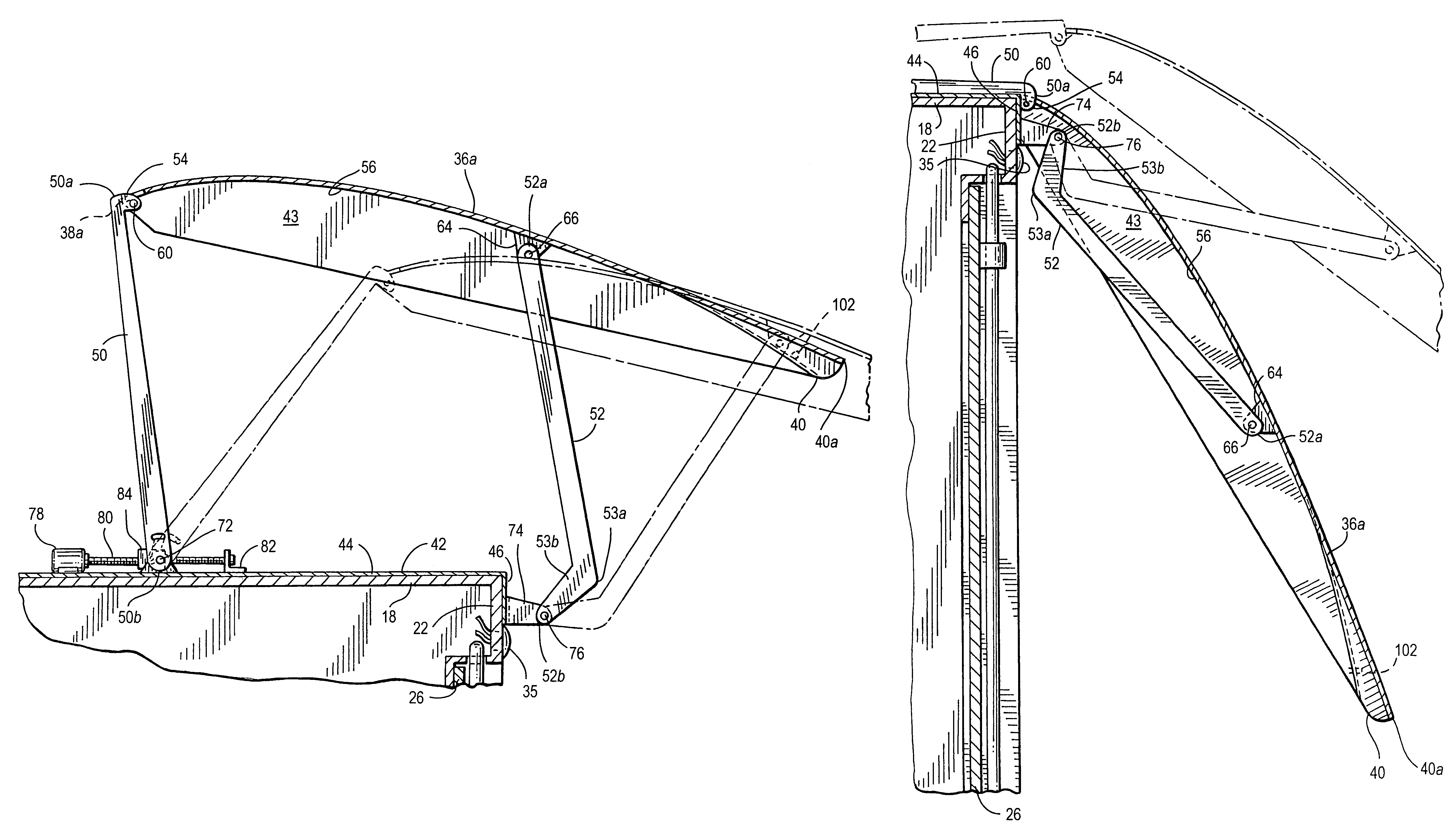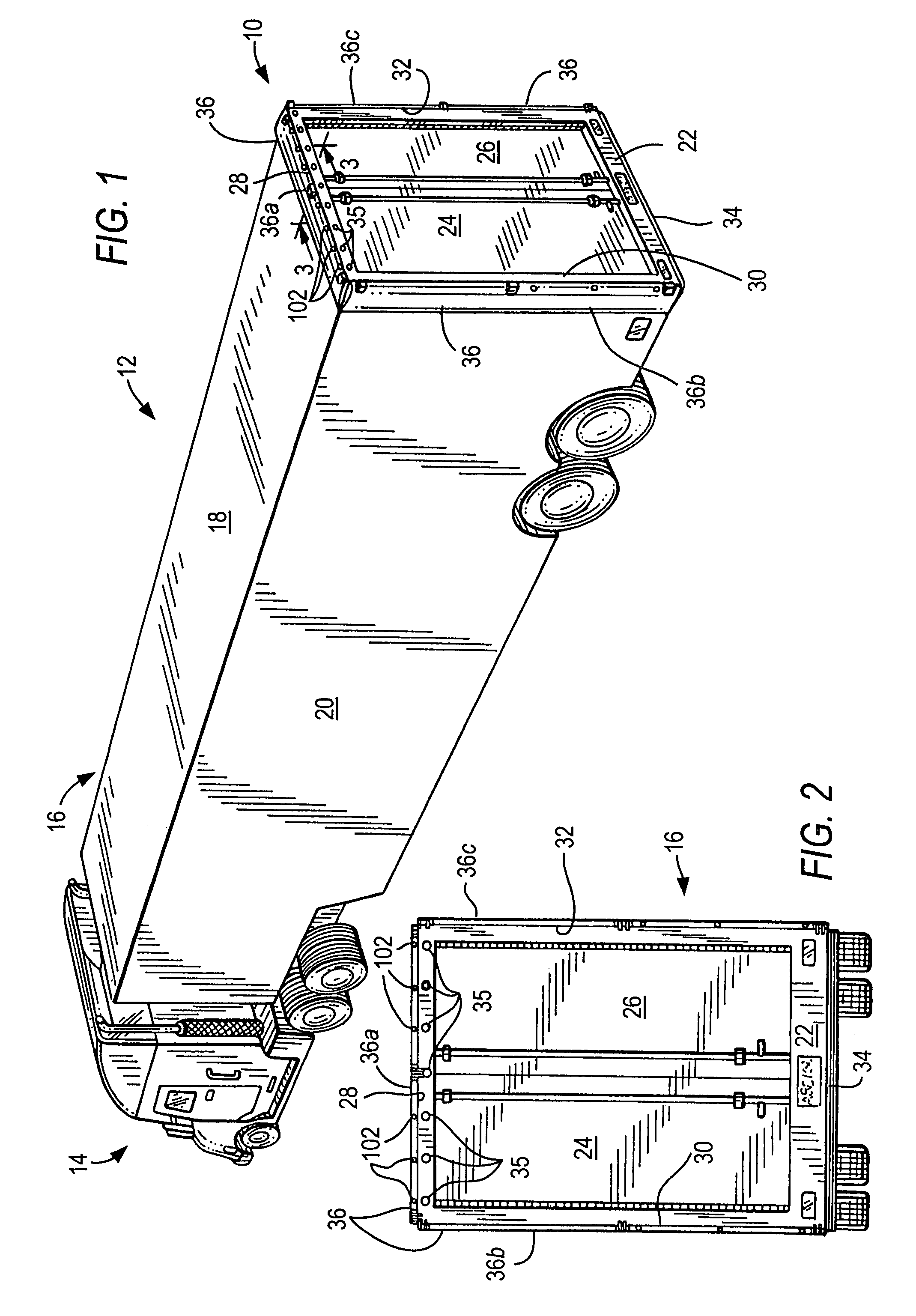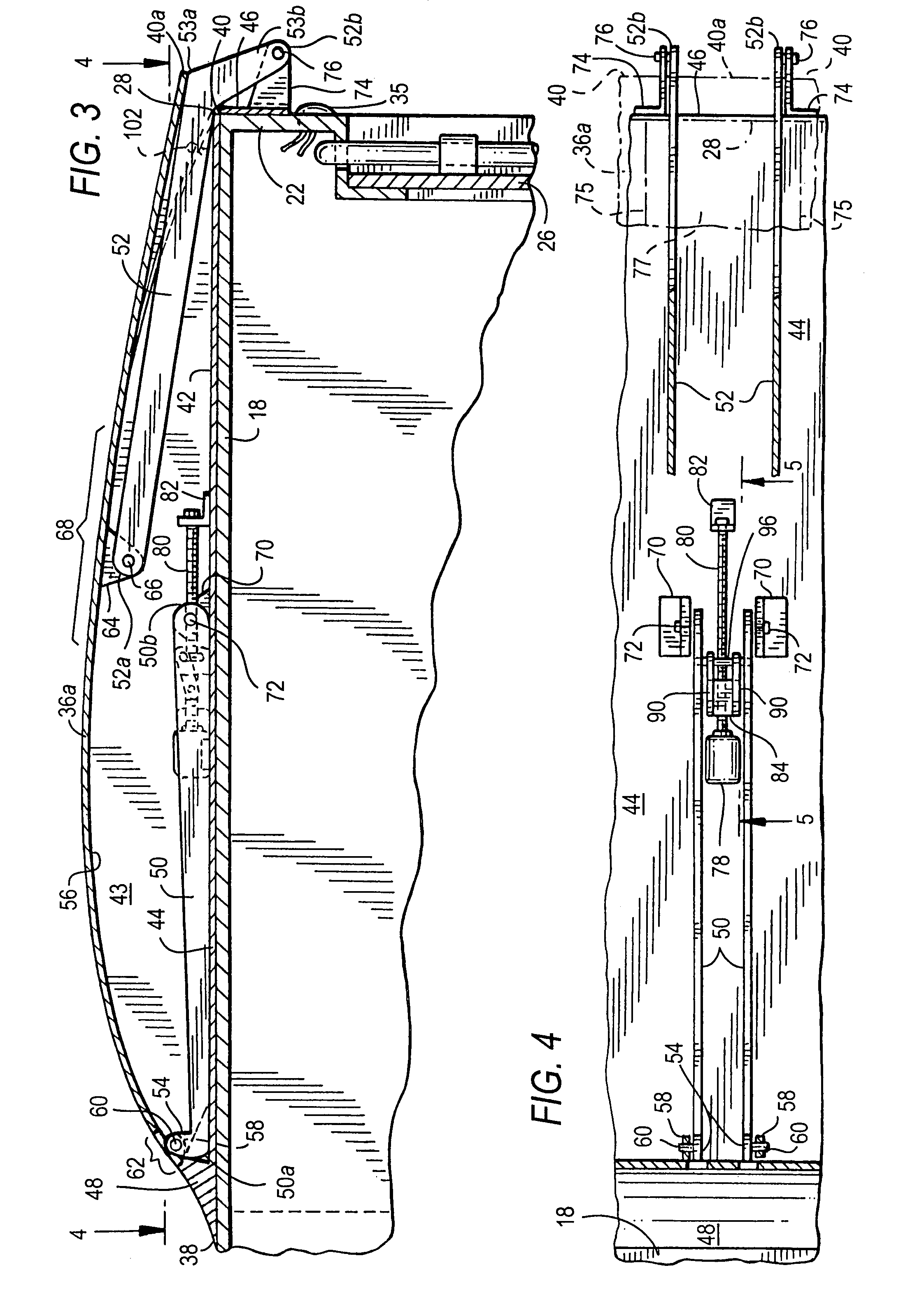Fuel consumption is a major
operating cost for trucking and other forms of transportation.
As fuel costs have risen, the expense of fuel has become an increasingly important component in the operating expenses associated with transportation, and as such it has become a factor that affects the profitability of individual transportation companies and of the
transportation industry generally.
Most trucks and other heavy land-based transport vehicles have boxy shapes which are inefficient aerodynamically, and therefore, when such a vehicle travels over a
route at normal operating speeds, air flow resistance at the front of the vehicle, which tends to increase headwind or frontal pressure, and drag-producing air flow phenomena at the rear and along the sides of the vehicle, which tend to decrease trailing air pressure and to increase friction, combine to retard the forward movement of the vehicle and have always been major factors in wasted fuel economy.
Specifically, in order to maintain a chosen speed, additional
engine power is required to overcome the air flow resistance and drag produced by these phenomena, which in turn leads to the consumption of more fuel.
As the speed of the vehicle increases, the effects produced by these phenomena can increase geometrically, such that at high operating speeds, most of the energy expended by the vehicle is consumed in overcoming these phenomena.
This frontal streamlining reduces the headwind, or front end pressure, but does nothing to address the similar but distinct problems caused by the air flow phenomena which produce drag, and which originate behind, or at or near the rear of such a vehicle, along its top and sides, to which the prior art has paid little attention.
The other factor that results in drag is due to an increase in friction arising from the disruption in laminar air flow longitudinally along the sides and along the top of a box-shaped vehicle as it progresses through the air along its forward path.
This disruption is characterized by eddies and turbulence that develop behind and along the top and sides of the vehicle as the laminar flow breaks down.
When traveling at slower speeds, the breakdown “boundary,” i.e., the point at which this effect is manifested, is located towards the rear of the vehicle, but as the speed increases, the breakdown boundary generally migrates forward, thus increasing the amount of friction experienced by the vehicle.
However, the first areas of such a vehicle that are affected by the breakdown in laminar flow are the top and sides, at or near the respective trailing edges.
However, the hinged panels of Roberge et al. are flat or planar, rather than curved, and they are attached to the hinged pair of rear cargo
doors which form a portion of the rear-facing surface of the vehicle; thus, they are caused to retract only when those cargo
doors are opened, and they cannot be used with vehicles that employ a single, “roll-up” rear cargo door (rather than a pair of swinging cargo
doors), since no means to access such a unitary door (or the cargo inside) is provided.
Moreover, these panels, which primarily provide for an improved laminar flow by altering the shape, i.e., by streamlining, the rear side and upper rear edges of the trailer, do not directly address the problem of reduced trailing pressure, and therefore do not divert the air sufficiently to alleviate the area of low pressure behind the vehicle (although a modest diversion or deflection of the airstream does occur as the air is “bent” slightly around the panels).
As a result, the solution proposed by Roberge et al. functions best only at higher operating speeds, since it does not provide for “scooping” or “ducting” of the air, which is desirable at lower operating speeds in order to reduce the trailing low pressure behind the vehicle as well as to improve the laminar flow along the top and sides of the vehicle.
On the other hand, while U.S. Pat. No. 5,280,990 to Rinard does provide curved, vertically-oriented side deflection vanes (as well as horizontally-oriented transverse upper and lower deflection ducts, which act to “scoop” or divert at right angles the air flow above, below and along the sides of the vehicle, and which are therefore primarily directed towards reducing the area of low pressure behind the vehicle), Rinard's air diversion elements do not directly address the additional drag caused by the breakdown in laminar flow along the top and sides of the vehicle (although a slight improvement in the laminar flow does occur simply by virtue of the reduction in the trailing low pressure that these elements do provide).
Nevertheless, and in contrast to Roberge et al., the solution proposed by Rinard works well to reduce drag only at lower operating speeds, but does not work well at higher operating speeds, when there is more of a need for the airstream to be diverted from the trailing top and side surfaces by flowing
over the air diversion elements, rather than being “ducted” under and / or through them.
In fact, at higher speeds Rinard's solution not only becomes less effective, it actually becomes counter-effective as the vehicle speed increases, because as the
airflow that is “ducted” through these elements increases, they eventually become aerodynamically resistive.
In addition, Rinard's side deflector vanes, like the planar panels of Roberge et al., are attached to the hinged pair of rear cargo doors which form a portion of the rear-facing surface of the vehicle, and although they can be displaced from their deployed position, this can be done only when the cargo doors of the trailer are opened, and even then, Rinard's side deflector vanes cannot be retracted to a fully flush position.
Thus, while these deflector vanes need not be directly deployed and retracted manually in order to provide access to the cargo doors, they nevertheless remain deployed unless and until the cargo doors are actually opened, and accordingly, they are susceptible to damage when the vehicle is being maneuvered into a narrow loading dock, and / or they can interfere with the driver's ability to monitor road conditions behind the vehicle, especially when it is being operated on local streets or otherwise at slow (i.e., non-highway) speeds, or when it is being backed into a loading dock, or when it is being parked.
Furthermore, during high speed travel the instabilities resulting from the breakdown in the laminar
airflow along the top and sides of the vehicle are likely to cause rapid oscillation of Rinard's side deflector vanes (despite their spring-biased mounting means), possibly resulting in those deflector vanes being damaged or, more likely, being forced by the unstable airflow into a “closed” position flush with the trailing edges of the vehicle body (completely overcoming the bias of the springs), and thereby making the vanes utterly ineffective to perform their intended air diversion or “scooping” function.
Thus, although the prior art appears to have recognized that the trailing upper (and, to a smaller degree, lower) edge of a box-shaped vehicle would create low pressure behind the rear of the vehicle when it is in motion, the prior art has failed to address that low pressure problem while also addressing the problems that arise from the simultaneous disruption of laminar flow along the top and sides of a vehicle.
The prior art has also failed to recognize that the magnitude of each of these problems, both absolutely and relative to one other, and the nature of their most effective solutions, will vary according to the speed of the vehicle, and the prior art has failed address these problems in a manner that can not only dynamically adjust, but can also optimize, those solutions as the speed changes.
While the drag problems resulting from the trailing low pressure and disruption of laminar flow described above are particularly acute for cargo-carrying vehicles which travel over highways and other paved or unpaved roads, such as conventional
tractor-trailers and other box-shaped trucks, and even squared-off passenger-carrying vehicles such as buses and sport-utility vehicles, they can also afflict other large land-based conveyances, particularly combination or “tandem”
tractor-trailer assemblies comprising two or even three box-shaped trailers, and even a succession of adjacent, squared-off railroad cars (regardless of whether those rail cars are used for carrying passengers or freight).
In the latter cases, in which there are multiple box-shaped container units, additional airflow inefficiencies are created, due to the breakdown in laminar flow in between the units caused by the gaps between the adjacent container bodies, which the prior art has also failed to address.
Moreover, Rinard's deflectors might actually have an undesirable, negative effect in this “tandem” context, since they will actually foster a breakdown in laminar flow at lower speeds than would otherwise be the case if those deflectors were not present, thus actually reducing, rather than improving, aerodynamic efficiency at any given speed.
Another related factor which can affect vehicle performance, and therefore fuel consumption, is the airflow both over and under the vehicle, as it moves along its
route at high speeds.
The prior art, as exemplified by the Rinard and Roberge et al. patents mentioned above, has failed to address the lift problem attributable to the Bernoulli effect in the same context as the problems created by the air flow phenomena which produce drag.
In summary, the prior art has failed to provide a solution that satisfactorily ameliorates all of the components of trailing drag which develop at or near the rear of a box-shaped vehicle, both behind it and along its top and sides, as it moves forward at normal operating speeds.
Moreover, and particularly for road vehicles, the prior art has failed to provide such a solution which at the same time does not hinder or obstruct the driver's view of the area surrounding the rear of such a vehicle when it is being operated at slower and maneuvering speeds, and does not interfere with access to, or with the opening and closing of, the rear cargo door(s) which could unduly prolong loading and / or unloading operations at a conventional loading dock.
Furthermore, and again particularly for road vehicles such as
tractor-trailers and other box-shaped trucks, the prior art has failed to provide such a solution which also helps to overcome the lifting force encountered at highway speeds.
Finally, the prior art has failed to appreciate that any measures used to counteract the aerodynamic inefficiencies that plague box-shaped vehicles must account for the fact that these aerodynamic instabilities, as well as the effectiveness of the countermeasures, will vary as the speed of the vehicle changes.
 Login to View More
Login to View More  Login to View More
Login to View More 


